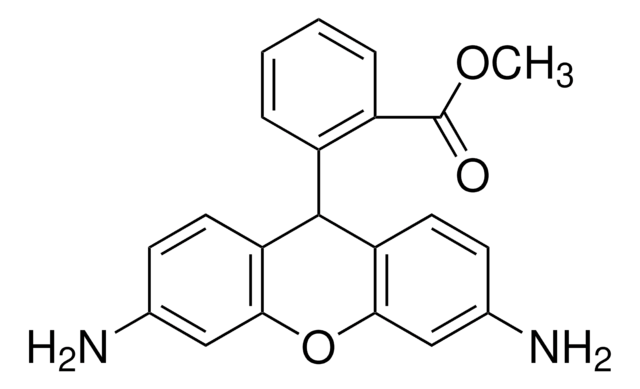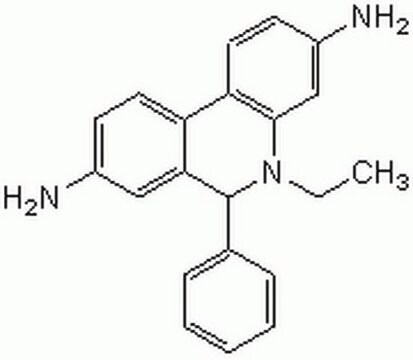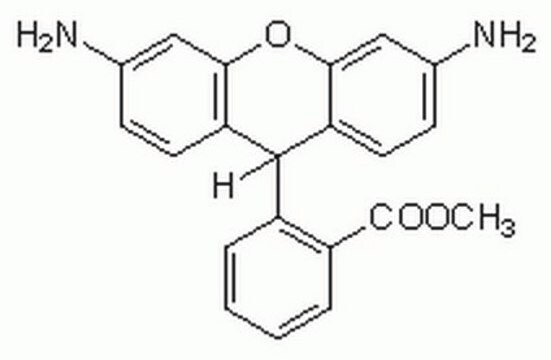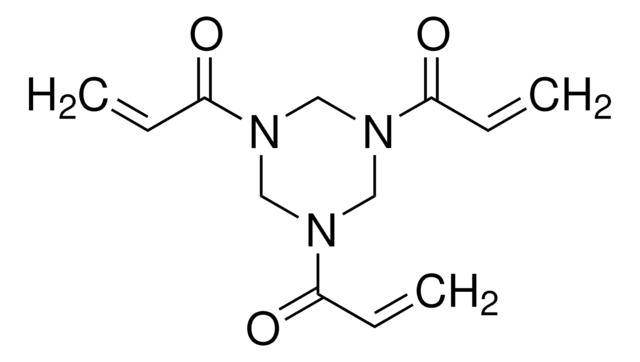H4290
Hydroxyphenyl fluorescein solution
5 mM in DMF
Synonym(s):
Hydroxyphenyl fluorescein, 2-[6-(4′-hydroxy)phenoxy-3H-xanthen-3-on-9-yl]benzoic acid, HPF
Sign Into View Organizational & Contract Pricing
All Photos(1)
About This Item
Empirical Formula (Hill Notation):
C26H16O6
Molecular Weight:
424.40
EC Number:
UNSPSC Code:
12352108
NACRES:
NA.32
Recommended Products
Looking for similar products? Visit Product Comparison Guide
Related Categories
General description
Hydroxyphenyl fluorescein solution, also known as HPF is a fluorescent probe, which upon oxidation by the hydroxyl radical (HO) returns a brilliant green fluorescence (HPF-ox). Increased HPF signals in antibiotic-exposed bacterial cells are explained by fluorescence associated with increased cell size, not by ROS levels. In cells incubated with the HPF probe and exposed to ampicillin and norfloxacin with HPF fluorescence correlated linearly.
Application
Hydroxyphenyl fluorescein solution is used to detect highly reactive oxygen species (hROS). It is a suitable probe to detect cellular death caused by bacterial antibiotics.
Fluorescent reagent for the detection of highly reactive oxygen species (hROS). Fluorescence intensity increases after the immediate reaction with hROS such as hydroxyl radical and peroxynitrite. Since HPF does not react with nitric oxide, superoxide and hydrogen peroxide, it can differentially detect peroxynitrite. HPF is resistant to light-induced autoxidation.
Features and Benefits
The following are the benefits of Hydroxyphenyl fluorescein solution:
- HPF is resistant to light-induced autooxidation.
- Hypochlorite(-OCl) does not react with HPF.
- HPF does not react with nitric oxide, superoxide, and hydrogen peroxide.
- HPF has low reactivity with HOCl.
Signal Word
Danger
Hazard Statements
Precautionary Statements
Hazard Classifications
Acute Tox. 4 Dermal - Acute Tox. 4 Inhalation - Eye Irrit. 2 - Flam. Liq. 3 - Repr. 1B
Storage Class Code
3 - Flammable liquids
WGK
WGK 2
Flash Point(F)
135.5 °F - (Dimethylformamide)
Flash Point(C)
57.5 °C - (Dimethylformamide)
Personal Protective Equipment
dust mask type N95 (US), Eyeshields, Gloves
Choose from one of the most recent versions:
Already Own This Product?
Find documentation for the products that you have recently purchased in the Document Library.
Ken-ichi Setsukinai et al.
The Journal of biological chemistry, 278(5), 3170-3175 (2002-11-07)
We designed and synthesized 2-[6-(4'-hydroxy)phenoxy-3H-xanthen-3-on-9-yl]benzoic acid (HPF) and 2- [6-(4'-amino)phenoxy-3H-xanthen-3-on-9-yl]benzoic acid (APF) as novel fluorescence probes to detect selectively highly reactive oxygen species (hROS) such as hydroxyl radical (*OH) and reactive intermediates of peroxidase. Although HPF and APF themselves scarcely
Our team of scientists has experience in all areas of research including Life Science, Material Science, Chemical Synthesis, Chromatography, Analytical and many others.
Contact Technical Service










